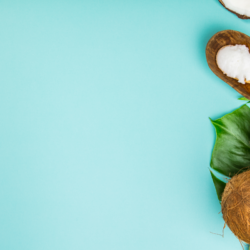Castor oil, extracted from the seeds of the‘Ricinus communis‘ plant, is renowned for its many virtues, particularly when it comes to skin care. Its richness in essential fatty acids and vitamin E makes it an ingredient of choice in the world of cosmetics. But is it really a miracle cure for skin and hair? This article explores its properties and applications from a scientific and technical angle.
What is the chemical composition of castor oil?
The chemical composition of castor oil(Ricinus Communis L.), a member of the Euphorbiaceae family and mainly native to India, is remarkably rich and diverse. The extraction of this oil, obtained by first cold pressing the seeds, enables it to retain all its properties.
In terms of fatty acid composition, castor oil is characterised by a high concentration of ricinoleic acid (80 to 92%), a fatty acid unique to this oil. Ricinoleic acid is renowned for its moisturising and regenerative properties, contributing significantly to the oil’s benefits for the skin.
The oil also contains a variety of other fatty acids, each providing its own benefits.Linoleic acid (omega 6 PUFA, 3 to 8%) and linolenic acid (omega 3 PUFA, 0.5 to 2%) are known for their anti-inflammatory properties, which are essential for maintaining healthy skin.Oleic acid (omega 9 PUFA, 2 to 8%), meanwhile, plays a role in keeping the skin moisturised and regulating its lipid balance.
Among the other components,palmitic acid (SFA, 1 to 4%) and stearic acid (SFA, 1 to 5%) contribute to the consistency and texture of the oil, making it easier to apply and absorb by the skin.Arachidic acid (SFA, ≥ 2%) and eicosenoic acid (omega 9 MUFA, ≤ 1%) complete this rich and varied composition.
In terms of physical characteristics, castor oil has a density at 20°C varying between 0.945 and 0.970, giving it a relatively thick texture, ideal for topical application. Its high flash point (230) reflects its heat stability. Its peroxide value (10) and acid value (2,000) reflect its resistance to oxidation and its purity.
Castor oil’s chemical composition makes it a versatile ingredient in the world of skin care. Whether for its moisturising or anti-inflammatory properties, or for its role in combating skin ageing, castor oil stands out as a major ally in maintaining healthy, resilient skin.
What are the properties of castor oil or Ricinus Communis?
Castor oil is renowned for its many beneficial properties for the skin, thanks to its rich, complex composition.
Moisturising and nourishing:
Castor oil is particularly appreciated for its moisturising properties. Thanks to its high concentration of ricinoleic acid, it penetrates deep into the skin, providing intense hydration. This same fatty acid also gives it nourishing properties, making it the ideal plant oil for strengthening and promoting the growth of the skin’s appendages – hair, nails, eyelashes and even beards.
Anti-inflammatory and analgesic :
Its anti-inflammatory effects play a key role in reducing redness and skin irritation. Castor oil also has analgesic properties, soothing many skin conditions.
Antiviral and antibacterial:
Its antimicrobial activity is particularly interesting. Castor oil could help combat illnesses such as influenza, gastroenteritis and fungal infections. It also cleanses the scalp and skin, creating a favourable environment for hair and beard growth.
Immunostimulant:
As an immunostimulant, this plant oil helps strengthen the body’s natural defences against pathogenic germs. It is therefore particularly effective in preventing seasonal illnesses.
Digestive, laxative, purgative :
Internally, Ricinus communis oil stimulates intestinal motility and the production of digestive enzymes. Although traditionally used as a laxative or purgative, its use for these purposes should be avoided due to its drastic effect, which irritates the intestines.
In pharmaceuticals, castor oil is used to obtain modified oils, such as polyoxyethylenated castor oil used in injectable preparations. Undecylenic acid, derived from ricinoleic acid, is used as an antifungal agent in the treatment of dermatophytes.
Cosmetological uses :
In cosmetology, derivatives of ricinus communis oil are widely used in the formulation of cosmetic products for their properties as plasticisers, consistency factors or solubilisers.Hydrogenated or oxyethylenatedcastor oil are examples of these derivatives. Castor oil, in its pure form, is also present in various products, such as lip sticks, accounting for up to 50% of their composition.
In short, castor oil has a multitude of beneficial properties for the skin and beyond, making it a valuable ingredient in both cosmetics and traditional medicine.
Is castor oil effective in removing dark circles and spots from the face?
The question of the effectiveness of castor oil in the treatment of dark circles and spots on the face has been the subject of an exploratory clinical study. The study was conducted at the Shahid Faghihi Dermatology Clinic and the Molecular Dermatology Research Centre affiliated to Shiraz University of Medical Sciences between September 2021 and February 2022.
Castor oil, extracted by cold pressing from the seeds of Ricinus communis, is known for its anti-inflammatory, antimicrobial and antioxidant properties, as well as promoting wound healing. Its rich composition in ricinoleic acid, as well as linoleic, oleic, stearic and palmitic acids, gives it potentially beneficial properties for the skin.
The trial “Efficacy of castor oil cream in treating infraorbital hyperpigmentation: An exploratory single-arm clinical trial” included adults suffering from infraorbital hyperpigmentation (dark circles). A topical cream containing 10% castor oil was applied twice daily to the infraorbital areas for 2 months. The results were evaluated in terms of changes in the levels of melanin and erythema under the eyes, measured using specialised equipment.
Can castor oil be used to reduce dark circles?
The application of castor oil-based cream resulted in a significant reduction in infraorbital darkness. According to the VisioFace® analysis, the level of darkness decreased by more than five points, an improvement considered to be significant. In addition, SkinColorCatch® measurements indicated a significant reduction in infraorbital melanin levels, although no significant change in erythema values was observed. This improvement in hyperpigmentation and skin texture was also accompanied by significant patient satisfaction.
The results of this study suggest that castor oil could be a promising option for the treatment of dark circles and spots on the face, particularly in cases of infraorbital hyperpigmentation. Its rich composition and anti-inflammatory and moisturising properties appear to help reduce pigmentation and improve the appearance of the skin.
How do I get rid of melasma and hyperpigmentation with castor oil?
Ricinoleic acid, a bioactive element contained in castor oil, is recognised for its beneficial properties in the treatment of brown spots on the skin. Studies suggest that this compound may help to reduce or even depigment these skin imperfections. What’s more, thanks to its antioxidant properties, castor oil can also help prevent the appearance of new spots.
For optimum application, we recommend massaging a few drops of castor oil into dark spots, morning and night.
As a complement, the use of essential oils such as Celery essential oil and Carrot essential oil can reinforce the depigmenting action of Castor oil. These essential oils can be combined with Ricin oil to obtain more effective results in the treatment of skin pigmentation spots.
Is castor oil effective on scars and stretch marks?
Castor oil plays a crucial role in skin regeneration and healing, essential attributes for maintaining healthy, resilient skin.
- Stimulation of collagen and elastin production: This exceptional oil stimulates the production of collagen and elastin, two proteins vital to the skin’s health and elasticity. Collagen is responsible for the skin’s structure and firmness, while elastin keeps the skin supple and resilient. By promoting the production of these two proteins, castor oil helps to rejuvenate and strengthen the skin from within.
- Reduced appearance of scars and stretch marks: Castor oil is also renowned for its ability to reduce the appearance of scars and stretch marks. Thanks to its deep penetration into the skin’s layers, it facilitates the repair of damaged tissue and improves the appearance of scars. This is partly due to its anti-inflammatory and regenerative properties, which speed up the healing process and reduce inflammation around damaged areas.
- Deep hydration: In addition to its regenerative properties, castor oil is a powerful moisturiser. It provides deep hydration, which is essential for skin healing. Well-hydrated skin is more supple, which reduces the likelihood of new scars forming and helps to reduce stretch marks.
Does castor oil make hair grow?
Castor oil is an essential part of hair care rituals, thanks to its multiple benefits for the hair. Obtained from the seeds of the Ricinus communis plant, this oil has a rich composition including ricinoleic acid, fatty acids and glycerides, giving it highly moisturising and nourishing properties. Its germicidal and fungicidal properties make it a precious ally in protecting the scalp and hair against infection.
Ricinoleic acid plays a crucial role in maintaining healthy hair. Indeed, studies suggest that it may help combat androgenetic alopecia by inhibiting the activity of prostaglandin D2 synthase ( PGD2), a key element in the hair loss process. This preventive action against hair loss makes castor oil a product of first choice in hair care routines.
Thanks to its unique characteristics and proven benefits,castor oil is a natural and effective solution for nourishing, moisturising and protecting hair, offering a valuable alternative to conventional products. By incorporating castor oil into your hair routine, you can benefit from its regenerative properties and keep your hair healthy and radiant.
Precautions and side effects concerning castor oil
Certain precautions must be taken when using castor oil to ensure its safety and effectiveness.
When applied to the skin, it is advisable to dilute it with another more fluid vegetable oil to facilitate application and reduce the risk of irritation. Avoid contact with the eyes.
For oral use, it is advisable to consult a health professional. This method is not recommended for children, pregnant or breast-feeding women, people with fragile or sensitive intestines, people taking medication or people allergic to natural laxatives.
Storage: Keep castor oil in a cool place,away from light and heat.
Sources
- Moisturizers. Anne Harwood; Ali Nassereddin; Karthik Krishnamurthy. August 21, 2022.
- Polym Adv Technol. Author manuscript; available in PMC 2019 Mar 26.Bioactive polymeric formulations for wound healing
- Efficacy of castor oil cream in treating infraorbital hyperpigmentation: An exploratory single-arm clinical trial. November 2023
- Int J Trichology. 2022 May-Jun. Hair Oils: Indigenous Knowledge Revisited







